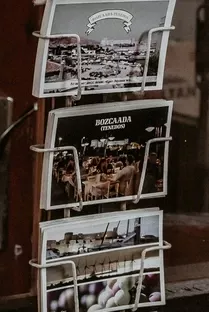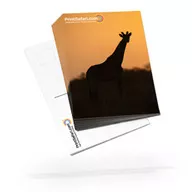Most Common Postcard Sizes
Postcards have played an essential role in communication and marketing for over a century. Postcard printing has evolved significantly, from early hand-painted cards to modern glossy prints, adapting to changing postal regulations, printing technologies, and consumer preferences. The United States Postal Service (USPS) has implemented size guidelines to standardize mailing costs and ensure efficient processing. Understanding these dimensions is crucial for businesses, collectors, and individuals who want to create or send postcards.

In the early 20th century, postcards varied significantly in size. However, as mailing efficiency became a priority, standard sizes emerged. Initially, postcards were smaller, often around 3.5 x 5.5 inches, allowing them to be processed easily. Over time, larger formats like 4 x 6 inches and 5 x 7 inches became more common, providing more space for images and messages. Today, these dimensions are widely used for personal and commercial purposes. Postcard printing has also advanced significantly, offering high-quality finishes and various paper types to enhance durability and visual appeal.
| Time Period | Typical Size |
| 1900-1950 | 3.5 x 5.5 inches |
| 1950-1980 | 4 x 6 inches |
| 1980-Present | 4.25 x 6 inches and larger |
The transition to standardized postcard sizes has helped streamline postal services. The most commonly used size today, 4 x 6 inches, is preferred because it qualifies for lower mailing rates while providing enough space for effective designs. Larger postcards, such as 5 x 7 inches or 6 x 9 inches, are used mainly for advertising, allowing businesses to showcase products with more visual appeal. By adhering to these dimensions, senders can ensure their postcards are processed efficiently and reach recipients without additional fees or delays.
Overview of Current and Past Postcard Sizes
Understanding the range of postcard dimensions available today can help individuals and businesses choose the right size for their needs. Below is an overview of common and past postcard sizes in the USA.
- Common Postcard Sizes Today:
- 4 x 6 inches – The standard postcard size, cost-effective and widely accepted for mailing.
- 5 x 7 inches – Popular for greeting cards and invitations, offering more space for designs.
- 6 x 9 inches – Frequently used for promotional mailers and marketing campaigns.
- 6 x 11 inches – A large format used primarily for Every Door Direct Mail (EDDM) marketing.
- Comparison with International Standard Sizes:
- Germany: DIN A6 (4.1 x 5.8 inches)
- United Kingdom: 4.1 x 5.8 inches
- Japan: 3.9 x 5.8 inches
- European Union: ISO 216 A6 standard (4.1 x 5.8 inches)

- Legacy and Historical Postcard Sizes:
- 3.5 x 5.5 inches – Common in the early 20th century, smaller than modern sizes.
- 4 x 5.5 inches – Used for early photography-based postcards.
- 5.5 x 8.5 inches – Occasionally found in vintage and oversized postcards.
Choosing the right postcard size depends on its intended purpose. Standard sizes are ideal for cost-effective mailing, while larger dimensions allow for more creative space and impactful marketing materials.
Need something custom that’s not on the list?
No problem – just file a custom request, and we’ll make it happen!
When selecting the perfect postcard size, it's important to consider both the aesthetic and functional aspects of your project. Standard sizes like 4 x 6 inches are ideal for budget-friendly, everyday mailing, while slightly larger sizes such as 5 x 7 inches provide more flexibility for creative designs and detailed messages. For marketing purposes, 6 x 9 inches and 6 x 11 inches offer significant space for impactful visuals, making them perfect for promotional campaigns or direct mail. On the other hand, international standards such as DIN A6 in Germany and ISO 216 A6 in the EU ensure a consistent approach for cross-border mailing. Understanding these different sizes helps ensure your postcards are effective in delivering your message, whether you're sending a simple greeting or launching an eye-catching marketing campaign. Ultimately, the choice of size should reflect the balance between your design needs and mailing requirements.
Additionally, when choosing a postcard size, consider how it will be perceived by your audience. A well-chosen size can enhance the visual appeal of your design and make your postcard more memorable. Larger postcards tend to stand out in a stack of mail, while smaller sizes might be better suited for quick, personal messages. Regardless of the size you choose, it’s crucial to ensure that your postcard’s design fits comfortably within the dimensions, leaving enough space for both visuals and text without appearing cluttered. With the right size, your postcard will not only be functional but also a powerful tool for communicating your message effectively.
EDDM (Every Door Direct Mail)
EDDM (Every Door Direct Mail) is a service provided by the United States Postal Service (USPS) that allows businesses to send marketing materials, such as printed flyers, postcards, and brochures, to every address within a specified geographic area without needing to know the individual recipient's name or address. This service is typically used by businesses to target specific neighborhoods or areas with promotional content. EDDM is beneficial because it offers cost-effective direct mail solutions for businesses of all sizes, allowing them to reach a large audience while reducing the expense of traditional mailing lists. It also simplifies the mailing process by eliminating the need for address labeling and sorting, making it a convenient option for businesses looking to boost local awareness and engagement.
Benefits of EDDM:
- Cost-Effective: Lower postage rates and no need for address lists reduce costs significantly.
- Wide Reach: Target entire neighborhoods or areas, ensuring that marketing materials reach a broad audience.
- Simplified Process: Eliminates the need for address sorting and labeling, saving time and effort.
- Increased Local Visibility: Ideal for businesses looking to enhance their presence in specific local communities.
- Flexible Marketing Tool: Suitable for various promotional materials, such as printed flyers, postcards, and brochures.
- No Address Requirement: Send to every door in a designated area without needing detailed recipient information.
Special Formats and Custom Postcards
When it comes to postcards, special formats such as square, panorama, or XXL designs can offer unique appeal for various occasions. These formats allow for more creativity, but they also come with specific benefits and limitations. Understanding the shipping costs and special requirements for each format is crucial before deciding which one to use for your project.
| Format | Description | Advantages | Limitations | Shipping Costs & Requirements |
| Square Postcards | Postcards in a square format (e.g., 5"x5") |
Eye-catching design Perfect for photography and art |
More expensive to print Less common format |
Higher shipping costs due to special format Special packaging may be required |
| Panorama Postcards | Postcards in a long, narrow format (e.g., 2.75"x8") |
Great for wide landscape shots Unique look |
Limited design options Typically more expensive than standard formats |
Shipping costs may vary depending on size Special packaging requirements |
| XXL Postcards | Extra-large postcards (e.g., 8,5"x11" or 9"x12") | Strong visual impact Ideal for promotional use |
Very expensive to print Less convenient for mailing |
High shipping costs, often sent as a package instead of a letter Special delivery requirements |
| Custom Postcards | Tailored formats, such as custom shapes or personalized designs | Fully customizable Perfect for specific events or marketing |
Very high production costs Longer production times |
Shipping costs depend on size and format Special packaging and handling may be necessary |
Conclusion:
Special formats allow for a more creative and unique design, making them ideal for specific marketing campaigns or personal occasions. However, these formats come with higher production and shipping costs, and may require special handling. Make sure to weigh the benefits against the added expenses and requirements when considering these formats for your next project.
Design Tips for Custom Postcards
When designing custom postcards, it's important to create a layout that is both aesthetically pleasing and functional. Be sure to use high-quality images that are optimized for printing, especially for larger formats where details become more noticeable. Text placement should be done carefully to ensure readability without overcrowding the design. Make sure the design complements the chosen format – for example, utilizing the horizontal space in panorama postcards or achieving balanced symmetry in square formats.

In addition to visual appeal, the design should also support the postcard's purpose. Ensure that key information, such as contact details, promotional messages, or calls to action, are clearly and attractively positioned. If the postcard is for a specific event or promotion, the design should reflect the brand or theme of that event. Remember that the back of the postcard is just as important as the front – it can be used for additional information or a personal message to engage the recipient more directly.
Frequently Asked Questions
What are the standard postcard sizes?
The most common standard postcard size is 4" x 6". However, other popular sizes include 5" x 7" and 3.5" x 5", which are typically used for both personal and business postcards.
What is the best size for a custom postcard?
The best size for a custom postcard depends on the design and purpose. For a more traditional look, the 4" x 6" size works well. If you want something unique or eye-catching, consider larger sizes like 5" x 7" or even 8" x 10". For promotional or marketing postcards, it's important to consider the amount of space needed for images, text, and branding.
Can postcards be printed in square or custom sizes?
Yes, postcards can be printed in square formats or custom sizes. Popular square sizes include 5" x 5" or 6" x 6". Custom sizes are also possible, but keep in mind that non-standard sizes might have different printing and shipping costs.
Are there extra costs for large postcard sizes like panorama or XXL?
Yes, larger postcard sizes such as panorama or XXL formats (e.g., 8.5" x 11" or 9" x 12") typically have higher production and shipping costs. These formats require more material for printing, and the shipping fees may increase due to the size, especially for international delivery.
How does postcard size affect postage costs?
Postcard size directly affects postage costs. Standard-sized postcards (4" x 6") usually qualify for the lowest postage rates. However, oversized or non-standard formats (like 5" x 7" or panorama sizes) may incur higher postage rates, as they do not meet standard mailing guidelines.
Create Your Unique Custom Postcards Today: Stand Out with Every Detail
Custom postcards are an excellent way to leave a lasting impression, whether you're promoting a business, celebrating a special occasion, or simply sharing a personal message. With countless design possibilities and a wide range of sizes, from traditional formats to custom options like panorama or XXL, you can tailor each postcard to fit your specific needs. A well-designed postcard doesn’t just communicate; it tells a story, captures attention, and sparks curiosity. Whether you want to showcase stunning photography, share a creative design, or promote an event, custom postcards offer the perfect platform to express your vision. By choosing the right size and format, along with high-quality materials, your postcards will not only stand out in a mailbox but also create a memorable experience for the recipient.
Get an Instant Print Quote for Your Postcards now!







